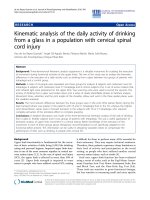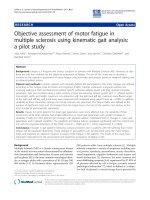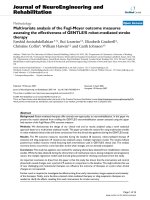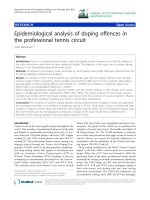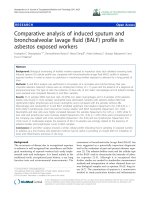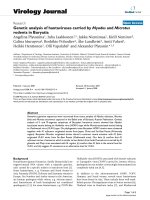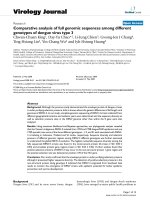báo cáo hóa học:" Eco-epidemiological analysis of dengue infection during an outbreak of dengue fever, India" pdf
Bạn đang xem bản rút gọn của tài liệu. Xem và tải ngay bản đầy đủ của tài liệu tại đây (483.32 KB, 7 trang )
BioMed Central
Page 1 of 7
(page number not for citation purposes)
Virology Journal
Open Access
Research
Eco-epidemiological analysis of dengue infection during an outbreak
of dengue fever, India
Anita Chakravarti* and Rajni Kumaria
Address: Department of Microbiology, Maulana Azad Medical College, Associated Lok Nayak Hospital, Bahadur Shah Zafar Marg New Delhi-
110002, India
Email: Anita Chakravarti* - ; Rajni Kumaria -
* Corresponding author
Dengue InfectionDengue feverIndiaRainfallTemperatureRelative humidity
Abstract
Background: This study was designed to find out a relationship of dengue infection with climatic
factors such as rainfall, temperature and relative humidity during the dengue fever epidemic in the
year 2003. Blood samples were collected from 1550 patients experiencing a febrile illness clinically
consistent with dengue infection. Serological confirmation of Dengue Infection was done using
Dengue Duo IgM and IgG Rapid Strip test (Pan Bio, Australia), which detected dengue-specific
antibodies. Monthly data of total rainfall, temperature and relative humidity for the year 2003 was
obtained from Meteorological Department of Delhi, New Delhi and retrospectively analyzed.
Results: Out of 1550 suspected cases, 893 cases (57.36%) were confirmed as serologically positive.
The difference between numbers of serologically positive cases during different months was
significant (p < 0.05). Larger proportions of serologically positive cases were observed among
adults. Outbreak coincided mainly with the post monsoon period of subnormal rainfall. The
difference between serologically positive cases as compared to serologically negative ones in post
monsoon period was significantly higher (p < 0.001). The difference in the rainfall and temperature
between three seasonal periods was significant (p < 0.05).
Conclusion: This prospective study highlighted rain, temperature and relative humidity as the
major and important climatic factors, which could alone or collectively be responsible for an
outbreak. More studies in this regard could further reveal the correlation between the climatic
changes and dengue outbreaks, which would help in making the strategies and plans to forecast any
outbreak in future well in advance.
Background
Dengue infection (DI) is amongst the most important
emerging viral diseases transmitted by mosquitoes to
humans, in terms of both illness and death [1]. The world-
wide large-scale reappearance of dengue for the past few
decades has turned this disease into a serious public
health problem, especially in the tropical and subtropical
countries [2-4]. It is estimated that 52% of the global pop-
ulation are at the risk of contracting Dengue fever (DF) or
dengue hemorrhagic fever (DHF) lives in the South East
Published: 14 April 2005
Virology Journal 2005, 2:32 doi:10.1186/1743-422X-2-32
Received: 11 February 2005
Accepted: 14 April 2005
This article is available from: />© 2005 Chakravarti and Kumaria; licensee BioMed Central Ltd.
This is an Open Access article distributed under the terms of the Creative Commons Attribution License ( />),
which permits unrestricted use, distribution, and reproduction in any medium, provided the original work is properly cited.
Virology Journal 2005, 2:32 />Page 2 of 7
(page number not for citation purposes)
Asian Region. Although all the four serotypes have been
circulating in this region, ecological and climatic factors
are reported to influence the seasonal prevalence of the
dengue vector, Aedes aegypti, on the basis of which coun-
tries in this region are divided in to four zones with differ-
ent DF/DHF transmission potential [5]. In most of the
countries, dengue epidemics are reported to occur, during
the warm, humid and rainy seasons, which favor abun-
dant mosquito growth and shorten the extrinsic incuba-
tion period as well [6-9].
DF has been known to be endemic in India for over two
centuries as a benign and self-limited disease. In recent
years, the disease has changed its course manifesting in
the severe form as DHF, with increasing frequencies [10]
Delhi City (India) is home to more than 13 million peo-
ple and is endemic for DI [11]. Overpopulation has con-
sequently led to poor sanitary conditions and water
logging at various places. A major epidemic of DHF from
Delhi was last reported in the year 1996 after which DI
became a notifiable disease and a number of policies were
formulated to bring the DI as well as its vector under con-
trol. The retrospective studies, one conducted by us during
the period, 1997–2001 and another by National Institute
of Communicable Diseases (NICD), New Delhi during
the year 1997, have observed a decline in the number of
cases having either DF or DHF in the following years
[12,13]. Although, the vector mainly responsible for the
spread of DI is present all the year around in Delhi, studies
on the relative prevalence and distribution have shown
the highest A. aegypti larval indices during the monsoon
and post monsoon period [13-15].
In the year 2003, India had experienced one of the wettest
monsoons in 25 years, which led to a spate of mosquito
growth creating an alarming situation of mosquito borne
diseases in many states. Delhi experienced an outbreak of
DF this year, after 6 years of silence. Studies conducted in
the countries like Brazil, Indonesia and Venezuela, where
DI is present either in epidemic or endemic form have
suggested a correlation between weather and pattern of
DI. Rain, temperature and relative humidity are suggested
as important factors attributing towards the growth and
dispersion of this vector and potential of dengue out-
breaks [2-4]. Since limited data is available on the associ-
ation of climatic conditions and the pattern of DI from
this geographical region, this study was conducted to find
out the relationship of dengue infection with climatic fac-
tors such as the rainfall, temperature and relative humid-
ity during the dengue outbreak in the year 2003.
Results
Seropositivity
All blood smears microscopically screened for malarial
parasite were found to be negative. Analytical interpreta-
tions presented in this study were based upon instructions
mentioned in the Pan Bio Rapid Strip Test procedure
manual. During the outbreak period, blood samples were
collected from 1550 patients experiencing a febrile illness
clinically consistent with DI over the period of one year
from January to December 2003. Eight hundred ninety
three cases (57.36%) were confirmed as serologically pos-
itive, out of which 199 (22.28%) cases were positive for
dengue-specific IgM antibodies indicating primary infec-
tion and 381 (42. 67%) cases were positive for both den-
gue-specific IgM and IgG antibodies indicating secondary
infection (Figure 1). IgG antibodies alone were also
detected in 313 (35.05%) cases and these cases were pre-
sumed to be either suspected secondary dengue infection
as IgG positivity alone could also be due to cross reactivity
with other flaviviruses. The difference between numbers
of serologically positive cases reported during different
months was significant (p < 0.05).
DI is observed to be a seasonal disease in Delhi. According
to intensity of rainfall, weather data was divided in three
periods, namely; pre monsoon period: from February-
May, monsoon period: from June – September and post
monsoon period: from October – January. Few cases clin-
ically suspected of dengue infection in the pre monsoon
period were later found to be serologically negative for
dengue-specific antibodies. During the monsoon period,
only 3 cases (0.34%) were confirmed serologically posi-
tive in the month of August, and 68 cases (7.6%) in the
September. Dengue-specific antibody positive cases were
mainly reported during the post monsoon period with
maximum number of cases 583 (65.3%) cases reported
Month wise distribution of primary and secondary serologi-cally positive cases during the outbreak period in the year 2003Figure 1
Month wise distribution of primary and secondary serologi-
cally positive cases during the outbreak period in the year
2003.
Virology Journal 2005, 2:32 />Page 3 of 7
(page number not for citation purposes)
during the month of October followed by 230 (25.76%)
cases in the November (Table 1). The difference between
numbers of serologically positive cases as compared to
serologically negative ones in post monsoon period was
significantly higher (p < 0.001), than during the remain-
ing period with 92% of total annual cases reported during
this period.
Distribution by age
Out of 893 serologically positive cases, 687 cases
belonged to the adult's age group (> 12 years) and 206
cases to pediatric age group (≤ 12 years) in this study.
Larger proportions of serologically positive cases were
observed among adults, with a positive prevalence of
56.4% among children and 58% among adults, distribu-
tion was however, not significantly different when com-
pared with pediatric age group (p > 0.05). The difference
between numbers of serologically positive cases among
adult and pediatric group in post monsoon period as
compared to the rest of the season was also not significant
(p > 0.05) (Table 2).
Climatic influence
Fig. 2a indicates that outbreak coincided mainly with the
post monsoon period of subnormal rainfall (Cumulative
rainfall = 30.3 mm) from October to December 2003 and
was followed by relatively heavy rainfall during the mon-
soon period; from June to September 2003. The difference
in the rainfall and temperature between three seasonal
periods was found to be significant (p < 0.05) (Fig. 2a
&2b). Mean ambient temperature was 25.4°C during the
pre monsoon period, which increased to 30.9°C during
the monsoon period; the period preceding the outbreak
and decreased to 20.3°C (Mean temperature from Octo-
ber to December) in the actual outbreak months during
the post monsoon period. The difference between relative
humidity during the three periods was not significant. The
mean relative humidity was 71.2% during the pre mon-
soon period. It increased during the monsoon period to
85% and increased further during the post monsoon
period to 90% (Fig. 2c).
Discussion
In the year 2003, India had experienced one of the wettest
monsoons in 25 years, which led to a spate of mosquito
growth creating an alarming situation of mosquito borne
diseases in Delhi and many other states [16]. As a conse-
quence to this unusually heavy rain, an outbreak of
dengue fever was once again reported from Delhi after a
silence of six long years. Most of vector borne diseases
exhibit a distinctive seasonal pattern and climatic factors
such as rainfall, temperature and other weather variables
Table 1: Month wise distribution of clinically diagnosed and serologically positive cases amongst primary and secondary cases during
the DF outbreak, 2003
Month Total Suspected cases Serologically Positive
cases (%)
Primary infection
(IgM Positivity)
Secondary infection
(IgM+ IgG Positivity)
Suspected secondary
infection (IgG Positivity)
August 12 3 (0.34%) 1 (0.5%) 1 (0.26%) 1 (0.32%)
September 157 68 (7.6%) 17 (8.6%) 24 (6.3%) 27 (8.6%)
October 982 583 (65.3%) 126 (63.3%) 246 (64.57%) 211 (67.4%)
November 362 230 (25.76%) 49 (24.6%) 110 (28.87%) 71 (22.68%)
December 37 9 (1%) 6 (3%) 0 (0%) 3 (1%)
Total 1550 893 (57.36%) 199 (22.28%) 381 (42.67%) 313 (35.05%)
Table 2: Month wise distribution of serologically positive cases amongst children and adults during the DF outbreak, 2003
Month Dengue-specific Antibody Positive cases
Total Children (Positivity %) Adults (Positivity %)
August 3 0 3 (25%)
September 68 18 (48.6%) 50 (41.7%)
October 583 133 (69.6%) 450 (57%)
November 230 54 (44.3%) 176 (83.8%)
December 9 1 (11.1%) 8 (28.6%)
Total 893 206 (56.4%) 687 (58%)
Virology Journal 2005, 2:32 />Page 4 of 7
(page number not for citation purposes)
a: Month wise distribution of serologically positive cases of dengue fever /dengue hemorrhagic fever and rainfall in Delhi for the year 2003Figure 2
a: Month wise distribution of serologically positive cases of dengue fever /dengue hemorrhagic fever and rainfall in Delhi for the
year 2003 b: Month wise distribution of serologically positive cases of dengue fever /dengue hemorrhagic fever and tempera-
ture in Delhi for the year 2003 c: Month wise distribution of serologically positive cases of dengue fever /dengue hemorrhagic
fever and relative humidity in Delhi for the year 2003
B
A
C
Virology Journal 2005, 2:32 />Page 5 of 7
(page number not for citation purposes)
affect in many ways both the vector and the pathogen they
transmit [17]. Worldwide studies have proposed that eco-
logical and climatic factors influence the seasonal preva-
lence of both the A. aegypti and dengue virus [2-4]. The
vector mainly responsible for the spread of DI is present at
the basal level all the year around in Delhi, however, stud-
ies on the relative prevalence and distribution have shown
the highest A. aegypti larval indices during the monsoon
and post monsoon period [13-15]. Since limited data is
available on the affect of climatic factors on the pattern of
DI, this study was planned to carry out the month wise
detailed analysis of three important climatic factors such
as rainfall, temperature and relative humidity on the pat-
tern of DI.
Observations on the seasonality were based on a single
year's data as the intensity of sampling was at its maxi-
mum during this outbreak period. The outbreak coin-
cided mainly with the post monsoon period of subnormal
rainfall, which was followed, by relatively heavy rainfall
during the monsoon period; from June to September
2003. The difference in the total rainfall and temperature
during three seasonal periods was found to be statistically
significant (p < 0.05). Monthly weather data showed that
temperature variations were more amongst different
months during the pre monsoon and post monsoon
period as compared to the monsoon period. Even though,
the monsoon season began in mid- June, there was no res-
pite from the heat as there was not much difference in the
temperature during the last month of pre monsoon; May
and beginning of monsoon in the June. Unusual heavy
rainfall subsequently led to decrease in temperature dur-
ing the later part of monsoon period. The temperature
showed a decline and remained almost constant during
the months of July and August (30.2°C), continuous
heavy rainfall subsequently led to further decrease in the
temperature during the month of September to 29°C. Rel-
ative humidity increased during the rainy season and
remained high for several weeks. An in-depth analysis of
these three factors thus led to a proposal that optimum
temperature with high relative humidity and abundant
stocks of fresh water reservoirs generated due to rain,
developed optimum conditions conducive for mass
breeding and propagation of vector and transmission of
the virus.
Our study was in tune with a previous study by NICD of
seasonal variations and breeding pattern of A. aegypti in
Delhi, which showed that there are two types of breeding
foci, namely; primary and secondary breeding foci.
Primary breeding foci served as mother foci during the pre
monsoon period. A. aegypti larvae spread to secondary
foci like discarded tyres, desert coolers etc., which collect
fresh water during the monsoon period [14]. This study
supported the proposal that all the three climatic factors
studied could be playing an important role in creating the
conducive condition required for breeding and propaga-
tion of this vector, the basal level of which is present all
round the year. This prospective study therefore high-
lighted the major important factors, which could alone or
collectively be responsible for an outbreak.
In our study, the largest proportion of serologically posi-
tive cases was recorded in the post monsoon period,
which is in agreement with our previous study [12]. Our
findings were in coordination with study by other groups
from this geographical region [13-15]. The seasonal
occurrence of positive cases has shown that post monsoon
period is the most affected period in Bangladesh as well
[18]. However, a retrospective study from Myanmar dur-
ing 1996–2001 reported the maximum cases of dengue
during the monsoon period [19]. Study by group of
Rebelo from Brazil has also emphasized the importance
of season. They have observed that dengue cases were
higher during rainy season showing the importance of
rain in forming prime breeding sites for A. aegypti thus
spread of DI [20]. Study of eco-epidemiological factors by
Barrera et al [21] showed that DF has a positive
correlation with the relative humidity and negative rela-
tion with evaporation rate. Peaks of dengue cases were
observed to be near concurrent with rain peaks in this
study from Venezuela showing a significant correlation of
intensity of DI with the amount of rain [21]. In this study
we have observed that temperature tends to decrease
towards the end of monsoon period, specially remains
moreover constant during the later months of rainy sea-
son. India and Bangladesh fall in the deciduous, dry and
wet climatic zone. The temperature remains high during
the pre monsoon period. It is continuous rain pour for a
couple of days that brings down the temperature during
the monsoon period, which may also be responsible for
an increase in the relative humidity and decrease in the
evaporation rate thus maintaining secondary reservoirs
containing rain water. More studies are needed to estab-
lish the relationship between the climatic changes and
dengue outbreaks, which would help in formulating the
strategies and plans to forecast any outbreak in future,
well in advance.
Very little dengue is found in adults in Thailand, presum-
ably because people acquire complete protective immu-
nity after multiple DI as children [1], as DI is highly
endemic in Thailand [22]. On the other hand, DI espe-
cially DHF is an emerging disease in India; probably this
may be the reason that people of all the age are found to
be sensitive to infection in our study. Even though more
adults were reported of having anti dengue antibodies, the
difference in the number of positive cases was not signifi-
cant as compared to pediatric age group.
Virology Journal 2005, 2:32 />Page 6 of 7
(page number not for citation purposes)
The severity of this outbreak was lesser as compared to the
DHF epidemic that occurred in year 1996 caused by the
serotype Den-2 [23]. Serotype Den-2 is reported to be the
one mainly associated with DHF, the more severe form of
the disease [24,25]. More studies in this regard can further
elucidate correlation of serotypes with severity of disease
from this geographical region.
Conclusion
This prospective study highlighted rain, temperature and
relative humidity as the major and important climatic fac-
tors, which could alone or collectively be responsible for
an outbreak. More studies in this regard could further
reveal the correlation between the climatic changes and
dengue outbreaks, which would help in making the strat-
egies and plans to forecast any outbreak in future well in
advance.
Materials and methods
Study design, population and sample size
The present study was conducted retrospectively for a
period of one year during the recent outbreak of dengue
fever in Delhi in the year 2003. The study population
comprised individuals of all age groups, attending the
outpatient and inpatient departments of Lok Nayak Hos-
pital, a tertiary care hospital in Delhi. Blood samples were
collected from 1550 patients experiencing a febrile illness
clinically consistent with dengue infection, selected
according to the following inclusion and exclusion
criteria.
Case-inclusion criteria
A case was included if there was high fever with clinical
symptoms suggestive of dengue infection as per WHO cri-
teria [26].
Case-exclusion criteria
A case was excluded, if routine laboratory testing sug-
gested bacterial or any viral infection other than dengue
infection or any other disease [26].
Microscopy for malaria identification
Venous blood was used for blood slide preparation for
malaria parasite examination. Thick and thin blood films
were prepared on the same slide, stained with Giemsa and
examined for the presence of malaria parasite.
Laboratory confirmation of dengue infection by serology
Dengue Duo IgM and IgG Rapid Strip test (Pan Bio, Aus-
tralia) was used for the detection of dengue-specific anti-
bodies. 1 µl of serum was mixed with 75 µl of buffer
(supplied in the kit) and test strip was dipped in to the
diluted serum. Results of the test were read after 30 min-
utes. Serum antibodies of the IgM or IgG class, when
present bind to anti-human IgM or IgG immobilized in
two lines across the test strip. Colloidal gold-labeled anti-
dengue monoclonal antibodies form complexes with the
dengue antigen that is captured by dengue specific IgM or
IgG in the patient's serum. These complexes were visual-
ized as pink/purple line(s). The presence of anti-dengue
IgM antibodies alone indicated primary infection. In con-
trast, presence of anti-dengue IgG antibodies with or with-
out IgM indicated secondary infection. (IgG antibodies
alone was considered as suspected secondary infection as
it could also be due to cross reactivity with other
flaviviruses).
Analysis of metrological data
Monthly details of total rainfall, temperature and relative
humidity for all the months of the year, 2003 were
obtained from Meteorological Department of Delhi, Mau-
sum Bhawan, New Delhi and retrospectively analyzed in
relation to total number of dengue cases. According to the
intensity of the rainfall, weather data was divided in three
periods namely; pre-monsoon period: from February-
May, monsoon period: from June – September and post
monsoon period: from October – January.
Competing Interests
The author(s) declare that they have no competing
interests.
Authors' contributions
It is stated that both the authors 1) have made substantial
contributions to conception and design, or acquisition of
data, or analysis and interpretation of data; 2) have been
involved in drafting the article or revising it critically for
important intellectual content; and 3) have given final
approval of the version to be published.
Acknowledgements
We thank the Metrological Department of Delhi, Mausum Bhawan, India
for providing the monthly weather details of rainfall, temperature and rela-
tive humidity for the year 2003.
References
1. Gubler DJ: Dengue and dengue hemorrhagic fever. Clin Micro-
biol Rev 1998, 113:480-496.
2. Teixeira MDG, Costa MCN, Guerra Z, Barreto ML: Dengue in Bra-
zil: Situation-2001 and trends. Dengue Bull 2002, 26:70-76.
3. Sukri NC, Laras K, Wandra T, Didi S, Larasati RP, Rachdyatmaka JR:
Transmission of epidemic dengue hemorrhagic fever in east-
ernmost Indonesia. Am J Trop Med Hyg 2003, 68(5):529-535.
4. Barrera R, Delgado N, Jimenez M, Valero S: Eco-epidemiological
factors associated with hyper endemic dengue hemorrhagic
fever in Maracay city, Venezuela. Dengue Bull 2002, 26:84-95.
5. WHO: Health Situation in the South East Asian Region 1998–
2000. WHO Regional Office, South East Asia, New Delhi .
6. Gibbons RV, Vaughn DW: Dengue: an escalating problem. BMJ
2002, 324:1563-1566.
7. Innis BL: Dengue and dengue hemorrhagic fever. In Kass hand-
book of infectious diseases: exotic virus infections Edited by: Porterfield JS.
London: Chapman and Hall Medical; 1995:103-146.
8. Rigau-Perez JG, Clark GG, Gubler DJ, Reiter P, Sanders EJ, Vorndam
AV: Dengue and dengue hemorrhagic fever. Lancet 1998,
352:971-977.
Publish with BioMed Central and every
scientist can read your work free of charge
"BioMed Central will be the most significant development for
disseminating the results of biomedical research in our lifetime."
Sir Paul Nurse, Cancer Research UK
Your research papers will be:
available free of charge to the entire biomedical community
peer reviewed and published immediately upon acceptance
cited in PubMed and archived on PubMed Central
yours — you keep the copyright
Submit your manuscript here:
/>BioMedcentral
Virology Journal 2005, 2:32 />Page 7 of 7
(page number not for citation purposes)
9. McBride WJ, Bielefeldt-Ohmann H: Dengue viral infections:
pathogenesis and epidemiology. Microbes Infect 2000,
2:1041-1050.
10. Ramalingaswami V: Presentations to participants: The changing
paradigms of dengue. Dengue outbreak in Delhi: Round table confer-
ence series: Ranbaxy Science Foundation; 1996:7-9.
11. Kabra SM, Verma IC, Arora NK, Jain Y, Kabra V: DHF in children
in Delhi. Bull WHO 1992, 45:105-108.
12. Chakravarti A, Kumaria R, Sharma VK, Berry N: Serodiagnosis of
dengue infection by rapid immuno chromatography test in a
hospital setting in Delhi, India, 1999–2001. Dengue Bull 2002,
23:109-112.
13. Sharma RS, Panigrahi N, Kaul SM, Shivlal , Barua K, Bhardwaj M: Sta-
tus report of DF/DHF during 1998 in the National Capital
Territory of Delhi, India. Dengue Bull 1999, 23:109-112.
14. Katyal R, Singh K, Kumar K: Seasonal variations in A. Aegypti
population in Delhi, India. Dengue Bull 1996, 20:78-81.
15. Kumar RR, Kamal S, Patnaik SK, Sharma RC: Breeding habitats and
larval indices of Aedes aegypti (L) in residential areas of
Rajahmundary town, Andhra Pradesh. Ind J Med Res 2002,
115:31-36.
16. Report- 10 died, about 1400 affected by Dengue fever in
Indian Capital. Source: Agence France-Presse (AFP) [http://
www:afp.com]. 19 October 2003
17. Gubler DJ, Reiter P, Ebi KL, Yap W, Nasci R, Patz J: Climatic varia-
bility and change in the United States: Potential impacts on
vector and rodent-borne diseases. Environ Health Perspec 2001,
109:223-249.
18. Amin MMM, Hussain AMZ, Murshed M, Chowdhury IA, Mannan S,
Chowdhuri SA, Banu D: Sero-Diagnosis of dengue infection by
haemagglutination inhibition test (HI) in suspected cases in
Chittagong, Bangladesh. Dengue Bull 1999, 23:34-38.
19. Naing CM, Lertmaharit S, Naing KS: Time-series analysis of den-
gue fever/Dengue hemorrhagic fever in Myanmar since 1991.
Dengue Bull 2002, 26:24-32.
20. Rebelo JM, Costa JM, Silva FS, Pereira YN, da Silva JM: Distribution
of Aedes aegypti and dengue in state of Maranhao, Brazil.
Cad-Saude-publica 1999, 15(3):477-486.
21. Barrera R, Delgado N, Jimenez M, Valero S: Eco-epidemiological
factors associated with hyperendemic dengue hemorrhagic
fever in Maracay city, Venezuela. Dengue Bull 2002, 26:84-95.
22. Strickman D, Kittayapong P: Dengue and its vectors in Thailand:
Introduction to the study and seasonal distribution of Aedes
Larvae. Am J Trop Med Hyg 2002, 67(3):247-259.
23. Seth , Singh UB: Use of predicted amino acid sequence of enve-
lope- nonstructural protein 1 region to study molecular evo-
lution of epidemic -causing dengue-2 strains. Dengue Bull 1999,
23:18-23.
24. Kalayanarooj S, Nimmannitya S: Clinical and laboratory presen-
tations of dengue patients with different serotypes. Dengue
Bull 2000, 24:53-59.
25. Vaughn DW, Green S, Kalayanarooj S, Innis BL, Nimmannitya S, Sun-
tayakorn S: Dengue viremia titer, antibody response pattern
and virus serotype correlate with disease severity. J Infec Dis
2000, 181:2-9.
26. Dengue hemorrhagic fever: Diagnosis, treatment, preven-
tion and control. 2nd edition. WHO: Geneva ; 1997.



